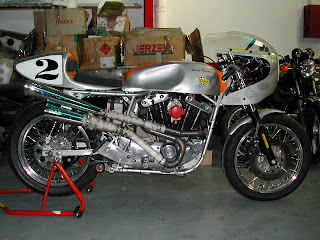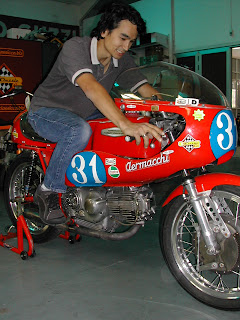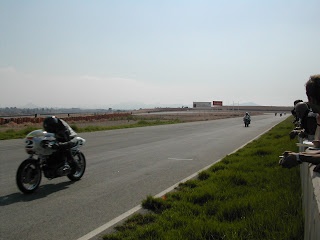In the late spring of 2005 I received an email about a Harley Davidson XR-1000 race bike I had just sold. The email was from Mauro Abbadini from Arganda del Ray, located just outside Madrid , Spain. Mauro, an Italian living in Spain runs Classic Co. , a race shop dedicated to making Moto Guzzi, Ducati, Laverda and Moto Morini's go fast. He was looking to buy a Harley or parts for one. He bought a XR-1000 factory fairing from me and we shipped it over to him. Pictured below is one of his bikes with a quarter fairing.
After discussing our common ground, my desire to race overseas and that I was, in fact born in Madrid, an invitation was made for me to come and race with DECCLA, the vintage racing group put on events Spain for classic endurance racing. As I'd left the country when I was just three years old, I asked my mother, who is Irish, but fluent in the language to come along so that I might see where I lived as a child. She met my late father, who was serving in the US Air Force while they were both living there. Fellow racer Chris Marshall came along as well to round out the Team 20/20 Racing effort on the 500cc Moto Morini that Mauro would prepare for us for the four hour endurance race.
We caught a flight out that September direct to Madrid. Two days in town, visiting the Museo del Prado, the Thyssen-Bornemsisza and the Sofia brought us face to face with some of the greatest art in the world. Lazy afternoons were spent on the Plaza Mayor and the Gran Via. We also made a trip to calle de Rafael Calvo, the street where we lived in the early 1960's. Much to my surprise, we met someone who lived there when we did. I felt at peace finally seeing this place for the first time through adult eyes, rather than the black and white photos that formed my memories of early childhood.
Chris and I caught the train to Arganda del Ray and visited Mauro at his race shop, Classic Co. An amazing assortment of machines, including ex-Bol 'dor Guzzi's and Laverda's filled the lobby. Mauro spoke English with a Cockney accent that came from his time spent in the UK when he was younger. We saw the 500cc Morini for the first time and couldn't help but be impressed with the effort put in to prepare it.
The next day, Chris, my mom and I piled all our belongings into the Nissan Micra rental car and began the nearly four hour trip south east to Cartagena on the Costa del Sol where we would race. We were delighted to find that the coastal town was deep in the middle of La Gran Fiesta del Mediterraneo, the Carthagineses Y Romans, a spectacular week long party to commemorate the epic battle between the people of Cartagena and the Romans. That must explain why our starter was clad in Roman Gladiatorial costume for the race.
Practice was going well as I hustled the 'big' Morini around the circuit fighting off exhaustion while trying to stay out of the way of the fast Guzzi's that dominated the big classes. In the smaller classes Bultaco were the favorites.
Teams from Italy, Germany and the UK were on hand and things were looking promising until I handed the bike off. Chris jumped on board and roared away, but was back within two laps. The bike had a right side , street pattern shift which was different from what Chris and I usually rode. I may have missed an upshift and bent a valve when it over-revved. Chris may done the same, I'm not sure if this caused the failure. He heard a 'knock' in the engine and before long the seriousness of the issue was apparent. Despite an all-night trip back to race shop for parts, we could not salvage the situation. Algo se ha roto, no es justo ! We made the best of our practice time and put in laps on a borrowed Yamaha RZ350. We needed to find a slot to ride with another team, but all seats were accounted for and so we decided to pitch in and help crew for Mauro and his teamates on their Guzzi and Harley Sportster-based racers.
Quien gana?
The British team put up a major fight with a Honda CB500 racer, but were no match for the Guzzi powered locals. After a long day in the hot sun, dinner was prepared and much fun was had as we enjoyed our hosts hospitality. There was the largest Paella I've ever seen and it was delicious. Much Sangria was consumed by all except for me, preferring to stick to my Cerveza sin Alchohol.
We were awarded the 'Long Distance Award' for our efforts, but I was very disappointed to have come so far and not get to race. We bid our friends farewell and spent the next day on the beach at Marbella on the Costa Del Sol. I seriously contemplated what kind of life I could live here and vowed to return someday.
A mad dash back to Madrid included a very intense drive where we witnessed that indeed, the 'rain in Spain, falls mainly on the Plain' is true. The month long drought had come to an end and the sky's opened up, but the mini-Micra behaved admirably despite the hours-long downpour.
Yes, it is the 'Museum of Ham' !
###

































































